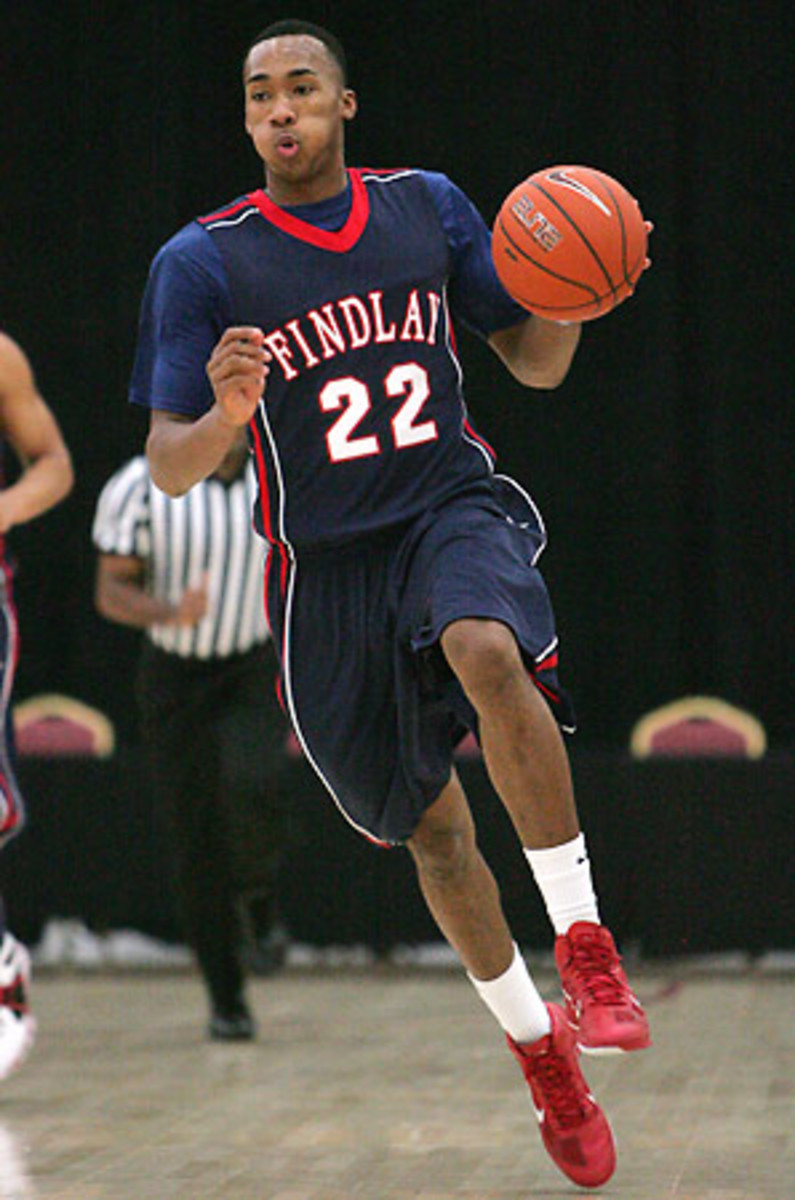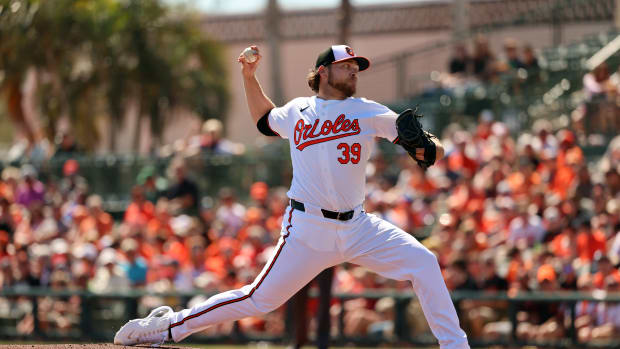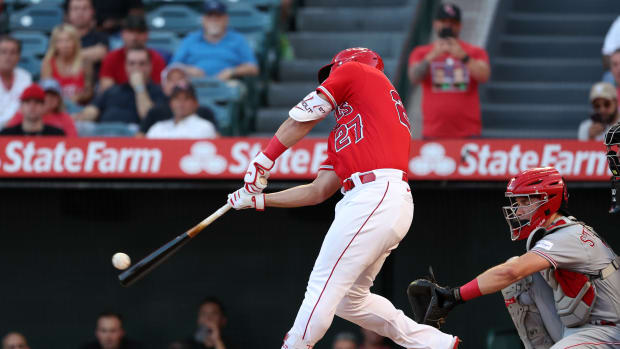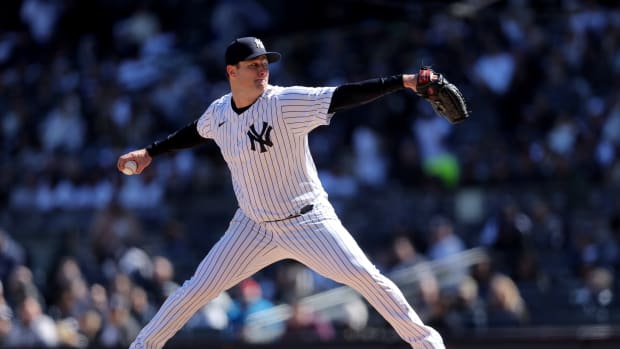
Prep star facing enviable choice: Big East hoops or pro baseball
Findlay's coach, Mike Peck, stood down the first base line with his daughter and one of his assistants. All but one of his players sat in the stands behind home plate, including Myck Kabongo, the five-star point guard who's expected to start for Texas next season, and Nick Johnson, the five-star shooting guard who's projected to start for Arizona. The day belonged to their teammate, Amir Garrett, a four-star small forward who's one of six Top 100 recruits signed by St. John's coach Steve Lavin, but who is no longer a certainty to suit up for the Red Storm.
Garrett was staging a one-man pitching audition a month before MLB's First-Year Player Draft, which begins on Monday. The 6-foot-5 lefthander cut an imposing figure on the mound, but neither his teammates nor the scouts knew what to expect. Garrett hadn't thrown in a game since June 2010, when he went straight from the NBA Players' Association's Top 100 Camp in Charlottesville, Va., to USA Baseball's Tournament of Stars in Cary, N.C. There he showed some life in his arm, but walked seven batters in 4 1/3 innings. Garrett said he wasn't in baseball shape then; he believes that had he focused on the game -- rather than going to Findlay, which only has a basketball team -- he would have been a top 10 prep baseball prospect. Which is why he and his father, Darrow, decided it would be worthwhile to give pitching one more shot before the end of high school.
"My dad always tells me," Amir said, "don't let good talent go to waste."
On March 6, following the conclusion of Findlay's regular basketball season, Garrett went to his hometown of Los Angeles to get instructions on a throwing program from Jaeger Sports. Its founder, Alan Jaeger, has developed a long-tossing and surgical-band exercise program that has benefitted pitchers such as Trevor Bauer, a UCLA righty who's expected to be a top five pick on Monday. Jaeger said Garrett's fastball was clocked in the mid-80s during that visit. Garrett stuck with the program in Nevada, and on recommendation from Orlando Cepeda Jr. of Legacy Sports Group, began receiving thrice-weekly instruction from Nick Aiello, the pitching coach at College of Southern Nevada, where phenom Bryce Harper played one season before going No. 1 overall in the 2010 MLB Draft.
"When Amir started here, he was pitching like a guy who was 5-9, not 6-5," said Aiello, who made key mechanical adjustments to stretch out Garrett's delivery. "Now, he's getting a ton of leverage."
Despite the fact that Garrett's unveiling was coming just two months after he'd returned to throwing, Aiello was confident it would be a success. He staked his reputation by telling scouting friends, in less refined language, that they would soil themselves when they saw Garrett's combination of size, athleticism and arm action in person.
With a horde of radar guns pointed at him on May 4, Garrett's fastball hit 92 miles per hour, then 93 and peaked at a stunning 96. News of it spread like wildfire among scouts; 22 more came back to see Garrett throw on May 24, and four more watched him on May 30. He hovered in the low 90s during the latter two sessions, which were less impressive, but he remains one of the more intriguing and mysterious prospects in this year's draft -- a David Price-sized lefty with an untaxed, explosive arm and barely any high school statistics. Jaeger, who has worked with scores of professional pitchers, said that the velocity Garrett was able to gain in just seven weeks was "mind-altering," and thinks he has yet to hit his radar-gun ceiling.
Like the scouts, Garrett's Findlay teammates were awed; many of them hadn't even known that he played baseball. When they found out about his arm, a few asked, "Why are you even here?" What they meant was, Why are you wasting time on basketball?
Garrett must make a difficult decision by Aug. 15, the signing deadline for MLB draftees. Multiple scouts told SI.com that based on potential, Garrett will be selected on Tuesday, when rounds 2-30 of the draft are held. His stock could rise or fall depending on how serious teams believe he is about playing pro baseball; according to sources, the Mariners had Garrett in Seattle for a private workout on Sunday and remain interested, as do the Red Sox. Garrett could choose not to sign and attempt to be a two-sport athlete at St. John's, which also has a strong baseball program. He could choose to play hoops at St. John's and professional baseball in the offseason. Or he could skip college basketball altogether and go all-in on professional pitching. What will he choose? It depends on whom you ask.
Lavin has been monitoring Garrett's diamond dalliance -- the coach will regularly ask him, "What's the [radar] gun saying?" -- but fully expects Garrett to be a part of the St. John's program in 2011-12, with an option to try out for the school's baseball team. In a statement released through a school spokesman, Lavin said, "We have encouraged Amir to continue working to develop into the best basketball and baseball player he is capable of becoming."
Garrett, however, could not guarantee to SI.com that he'd be enrolling at St. John's this year. Going to Findlay to play high school basketball on a major stage was an opportunity he decided he couldn't pass up, but he says baseball is his "first love." His father, Darrow, chooses to describe Amir as "a baseball player who plays basketball," and said Amir will seriously consider heading to rookie ball this summer if the money is right. Posturing of this sort is common leading up to the draft, but for what it's worth, a source close to the family said if Garrett was selected in the first seven rounds and offered a bonus of around $1.5 million, he would "drop everything" and enter the minors.
"I tell the [MLB] teams that we've created a relationship with St. John's that's hard to break," Darrow said. "It's going to take something extra reassuring, financially, to make it worth our while."
Even Peck, who helped Garrett grow into the No. 68 overall hoops prospect in the Class of 2011 according to Rivals.com, acknowledged the allure of pitching. "In my heart of hearts, I think this baseball thing has to be extremely appealing in terms of money, and the longevity of a baseball career," he said. "It's not like Amir is choosing between the NBA or the MLB right now -- he's choosing between amateur basketball or pro baseball."
The odds would seem to favor Garrett in baseball, if he can harness the power of his arm. He's viewed as a potential Big East star in basketball, but not a one-and-done NBA prospect, and he'll have to fight for playing time as a freshman: Of the six high school players who signed with St. John's for next season, he is the lowest-ranked in Rivals.com's Top 150. In baseball, he is far more unique.
"There might be 100 players in the NCAA and NBA that can match his size and athleticism, whereas there might be five in the whole country in baseball," Aiello said. "I think he realizes that when he gets off the bus in A-ball, there won't be anybody who looks like him."
Garrett laments, though, that getting off a bus in a small town in Montana won't be nearly as exciting as getting off one at Madison Square Garden. Picking pitching would mean spending at least three-four years away from the spotlight. "No matter what I choose, I'll be missing out on something," he said. "I'm kind of stuck right now."
There are worse kinds of stuck. If -- or rather, when -- Garrett's name is called on Tuesday, he'll have enviable options.


































